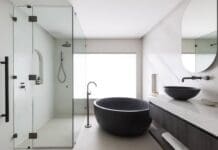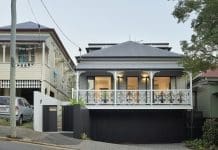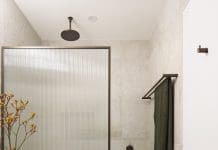It isn’t until you build a new home or undertake a major renovation that you realise just how much goes into construction! And an area that I was clueless on when we built our home was electrical and lighting planning. It was a major learning curve and I’m glad I called in the experts to get their advice. Not everyone has a Lighting Designer on speed dial so I’m sharing the main takeaways in this article. Oh, and I’ve added in a few new tips I learnt while studying to become an Interior Designer.
The decisions you make during a build will have an impact on how you live and enjoy your home. So it’s worth taking the time to create a considered electrical and lighting plan! A well-designed plan can set the mood in your home and make life more convenient. For example, having power points where you need them. Or could become cause for every day frustration.
Keep reading for 10 electrical and lighting things to consider when building.
Related article: What height to hang pendant lights?
Related article: Everything you need to know about lighting your bathroom

1. Do not over-light your interiors
It might sound strange but one of the most common lighting mistakes people make is to over-illuminate rooms. If you leave your lighting plan up to your electrician, they will commonly just suggest X downlights for the space. It usually leads to overly bright rooms with all of the light source coming from the ceiling.
Instead, start by thinking of the function of each room. By that I mean, what will you be doing in the room? Once you understand how you use the space, you can work backwards to select lighting that will support those tasks. For example, hallways are generally passageways to link you from one room to another. This means, you only need lighting to guide your path. So rather than filling your hallway with downlights, a more interesting and ambient solution could be to run low wall lights down your hallway. And then just having one or two ceiling or wall lights where they may be required, such as near heating and cooling control panels.
Bonus tip:
If you can, go to the next step of also considering how you will layout furniture in a room. This will help you to know where you want to create focal points. Or hang artwork that you can highlight with accent lighting.
Find more tips on creating a lighting plan for your home here.

2. Consider mixing lighting solutions
I mentioned in the point above how we should think beyond downlights when creating a lighting plan. And there’s a big world of choice out there!
Some lighting solutions you may like to use, include:
- pendant lights
- chandeliers
- wall sconces
- wall washes
- track ceiling lights
- spotlights
- linear strip lights
- step lights
- floor lamps.
My lighting designer encouraged me to use as few downlights as possible. Mainly because they cast downward shadows and you can create a much more ambient home — and more interesting home — by using a mix of lighting solutions.
I suggest taking the time to research all the lighting options out there before meeting with your electrician. That way, you can develop a plan that works and will add interest to your home.

3. Be careful not to date your house
A common design idea we see on The Block has to be strip lighting. But you don’t want to go overboard! During my lighting consultation, I asked whether or not it would be a good idea to run strip lighting along the kick of the kitchen. The response? A really strained look from my lighting designer. It was pretty clear the answer was no — haha! He said we could do whatever we wanted — it’s our house after all. Although, he wouldn’t recommend falling into lighting ‘trends’ or putting lighting in areas where it serves no real purpose. Essentially, running lighting under your island kick can look cool on TV but in everyday life, it will just illuminate how dirty your floors are. Sure enough, all these years later, we’re not seeing strip lighting used along the kick of the kitchen on The Block anymore.
When it comes to strip lighting, less is often more. Use it where you want to create an ambient mood or draw the eye to a feature. For example, I love how it has been used to highlight the decorative wall panelling in the image below. If you use it everywhere, it can make your home feel like a spaceship!

4. Automate lighting
Our lighting expert also suggested adding some automatic lights. For example, having a sensor when you open the butler’s pantry and in the garage so you don’t need to fumble in the dark. Small thoughtful details like this can make living in your home more comfortable.
Areas you may want to have lights on a sensor include:
- entry — for safety and convenience
- laundry — as your hands will often be full holding baskets of clothes
- pantry — for similar reasons but with shopping bags
- toilet night light — to avoid the need to turn on bathroom lights in the middle of the night
- garage — to make getting out of your car more comfortable
- driveway — this can be a real design feature and is a lovely way to be welcomed home each day.
There’s no limit to where you can use sensor lights — essentially anywhere you want additional safety or convenience. However, be mindful to only use these where it will not create issues. For example, I wouldn’t recommend having your hallway lights on a sensor as this could wake people during the night if someone has to duck to the loo.
5. Power point placement matters
We often see The Block judges giving the contestants flak for positioning power points in sight but truth is, sometimes they need to be. For example, in the dining area I asked for a power point behind the sideboard (out of sight and perfect for a table lamp). Luckily, our electrician was thinking practically — ‘What if you want to work on a laptop or charge a phone?,’ he asked. So we ended up adding some additional power points that were close to the dining table and wouldn’t be a trip hazard.
Similarly, I didn’t want to ruin the look of our kitchen island so I chose not to install power points on the side of the stone. Instead, I went with a low powerpoint on the wall next to the island. However, in hindsight this is something I would do differently. It is annoying using appliances on the kitchen island with cords running across the walkway — especially with young children who love to ‘help’ me cook. Next time, I will use either those pop up powerpoints that are concealed in the stone or use discreet switches on the side of the island.
My advice is to place the power points where it’s most practical and to make them discreet by choosing nice switch plates which takes me to the next tip…

6. Consider the switches
Lighting switches have come a long way and there are some truly stylish options on the market now. In our home, we chose the Clipsal Saturn Zen range (pictured below). I love the clean-line design of these and how I can replace the buttons with personalised images.
Recently, switches with bluetooth capability have hit the market. This makes it possible to automate all of your lighting from your phone without the need for a centralised electronic unit. And there are also plenty of new colour options available too. So you can find switch plates that will complement your interior scheme.

7. In-wall vacuum systems need to be planned early
When we were building our home we had our beautiful Rottweiler Arnie and to be honest, I made a lot of house decisions based on him — including moving our house over by a metre so he would have a path to view the street during the day! A practical decision I made was to install an in-wall vacuum system. And if you want to install one in your home, it needs to be considered early. This is because the system needs to be installed before the walls are plastered. Be sure to map out where you will have the hose outlets while considering furniture placement etc. so you can reach in and around everything. Oh, and also measure the distance between all of the outlets to ensure your hose is long enough to vacuum your entire home.
However, I should mention I don’t use our in-wall vacuum system any more. I didn’t find it to be very convenient… it’s actually quite clunky to drag the long hose from room to room. Instead I use our Vorwerk vacuum cleaner which is more powerful and easier to manoeuvre.
Alternatively, a stick vacuum may be more your style. It’s still a good idea to plan for this by ensuring you have a dedicated spot to store/charge it, such as a cabinet in your laundry or walk-in pantry. Make sure you have a powerpoint (or two) installed in this cupboard so you can keep all of devices charged.
8. Decide where to place control panels
Another of the electrical and lighting things to consider when building is where to position control panels — heating and cooling, lighting, home security etc. It’s a good idea to decide early what kind of technology you intend to use in your home so you know exactly what control panels you will have, and can decide on the most practical and least obtrusive place to position them. The last thing you want is a panel right next gorgeous artwork! For example, the TM Multi-Purpose Access Panel offers versatile placement options and easy accessibility for various control panels without compromising the aesthetics of your space. Additionally, it is essential to consider tested up to 2 hours fire-rated access panels for enhanced safety and compliance in building designs.
The most important part of creating a lighting plan is to start with function and adapt your lighting depending on the needs in the space. Be sure to also consider how much natural light there will be. Oh, and I also suggest putting a dimmer on every interior light!
9. Make provisions if you’re unsure or budget restricts
Building is so darn expensive and unfortunately your budget may be exhausted by the time it comes to lighting and electrical. Meaning all those plans for an integrated sound system, theatre room or statement pendant light might be in the air. My advice is to make provision for these things by running the cabling you need to those areas — that way you can add them when the timing is right.
For example, when we built our home, I knew I wanted some kind of lighting solution above our kitchen island but I could afford to spend any more on light fixtures. So I asked our electrician to leave a provision for another light source and years later, I installed this track light. Similarly, in our outdoor spaces, we made provisions for outdoor heaters down the track.

10. Walk through your decisions if you can
If possible, lock in your lighting plan once you’ve had the opportunity to walk through your framed house. This enables you to see exactly where light switches, power points and lights will be positioned — and make any necessary changes before it’s too late. Doing a walk through can also allow you to see new opportunities that you just can’t visualise from a plan.
Do you have other top electrical and lighting things to consider when building? Have you had some lighting fails? Did you try anything new and love the result? Let us know in the comments, we’d love to hear all about your electrical and lighting things to consider when building!
Check out more building and reno tips
This article was first published in May 2015 and has been updated with latest information and images








You made a great point about not mixing lighting solutions since they usually can take more time to research and figure out. My husband and I are looking to get a home electrical service upgrade since our house is over 20 years old. We will keep these tips in mind as we search for a professional that can help us best.
Glad these tips were useful Vivian. You can also find more lighting advice and inspo here https://stylecurator.com.au/category/products/lighting/ 😉
Hi Gina. I like the suggestion of thinking about what you will do in this room.
My electrician also asked me to think of journeys. For example, you are coming home with groceries. How many switches do you need to press to get to the fridge?
It is now 2018 and there are a few systems of smart lights (i.e. philips hue). These help you communicate with individual LEDs and you can add switches or dimmers by wish. The LEDs come in colors as well.You can also set themes. I saved a lot of money by installing philips hue rather than a suggested central system using dimmers. You can also spend a hundred dollars on a light stip that you can temove once we are past 2020, and move it to your kids room.
Regarding planning lights I would also suggest talking to others who have already built their houses. People remember their key learnings and they can also share what didn’t work. 🙂
Hi Irena
Thanks so much for your comment and suggestion to consider the ‘journey’ you take – great advice! And the tip about the LEDs is a great one too. My friend installed these at her house and it creates such a beautiful mood in the home, I’m thinking of doing the same at our house too. I definitely learnt a few things since building our house and am itching to build again, ha ha.
Great article. I like the idea of mixing light solutions. Will keep in mind all these tips while building my house.
Thanks Noah, all the best for your build!
Great tips Gina, especially the idea of making provision for things later. I wish we would have done more of that when building.
Thanks Sarah, I hope your build went well!